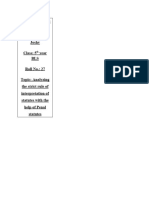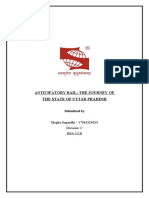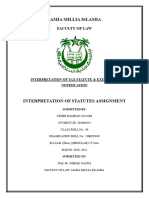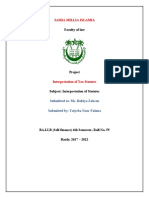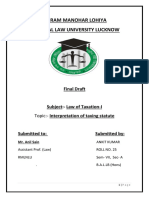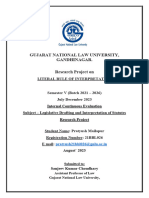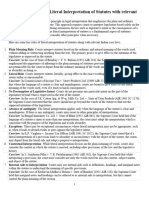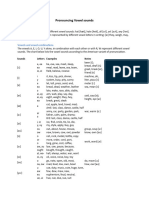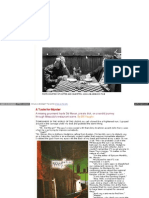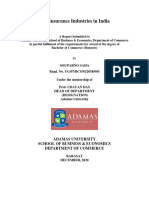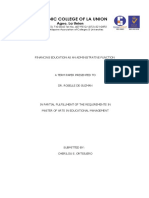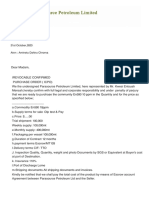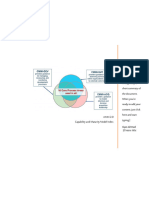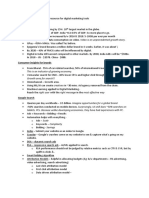INTERPRETATION OF STATUTES
TOPIC: STRICT INTERPRETATION AND RULE OF LAW: IS IT RELEVANT IN
LIBERALIZED ECONOMY?
SUBMITTED TO:
DR. SACHIN
(ASSISTANT PROFESSOR OF LAW)
RESEARCHED & AUTHORED BY:
SURUCHI SINGH
Enrollment No.- 1020202149
9TH SEMESTER
1|Pa ge
� ACKNOWLEDGEMENT
I would love to put a conversational expression of gratitude to Dr. Sachin, Assistant
Professor (Law), at National Law University, Shimla, for providing me an opportunity
through this project to explore Interpretation of statutes under the topic; Strict
interpretation and rule of law: is it relevant in liberalized economy? thereby helping
me assimilate within and pick up on it. I believe this will help me comprehend better
and get an enhanced hang on suits pertaining to this area of the Forensic science,
through this project analyzation.
DECLARATION
I hereby declare that this project work is original and is neither published nor under
consideration anywhere else.
DATE: 30/11/2024 SURUCHI SINGH
BALLB(Hons.)
2|Pa ge
� ABTRACT
The principle of strict interpretation plays a pivotal role in upholding the rule of law by ensuring
that laws are applied consistently and predictably. This approach requires judges and legal
practitioners to adhere closely to the literal meaning of legal texts, thereby limiting
discretionary powers and preventing arbitrary decisions. In the context of a liberalized
economy, the rule of law serves as a foundation for fostering trust, protecting property rights,
and ensuring fair competition. Strict interpretation becomes increasingly relevant as economies
liberalize, as it provides legal certainty to businesses, investors, and stakeholders navigating
complex regulatory frameworks. However, the balance between strict interpretation and
economic flexibility remains a critical challenge, as overly rigid application of laws may stifle
innovation and adaptation in dynamic markets. This abstract explores the interplay between
strict legal interpretation, the rule of law, and the demands of a liberalized economy,
emphasizing their combined significance in achieving a just and predictable legal system that
supports economic growth and fairness.
HYPOTHESIS
In a liberalized economy, a strict interpretation of the rule of law fosters predictability,
transparency, and fairness in economic transactions, thereby encouraging investment and
innovation. However, excessive rigidity in legal interpretation may hinder adaptability and the
efficient functioning of markets, necessitating a balance between strict adherence to legal
principles and pragmatic flexibility to accommodate evolving economic dynamics.
AIMS & OBJECTIVES
• To examine the historical and theoretical foundations of strict interpretation and the rule of law.
• To identify the challenges and opportunities of implementing strict legal frameworks in
liberalized economies.
• To evaluate case studies of economies where the rule of law has significantly influenced
liberalization policies.
• To recommend best practices for harmonizing legal strictness with the dynamic demands of
liberalized markets.
3|Pa ge
� TABLE OF CONTENT
• ABSTRACT………………………………………………………3
• HYPOTHESIS……………………………………………………3
• AIMS & OBJECTIVES…………………………………………..3
• STRICT INTERPRETATION…………………………………….5
• STRICT INTERPRETATION OF PENAL STATUTES………….5
• STRICT INTERPRETATION OF TAXING STATUTES………..6
• RULE OF LAW………………………………………………….8
• RULE OF LAW & ECONOMIC DEVELOPMENT……………10
• RULE OF LAW & LIBERALIZED POLICIES IN INDIA……..11
• STRICT INTERPRETATION OF LAW IN A LIBERALIZED ECONOMY….12
• CHALLENGES…………………………………………………..13
• A BALANCING APPROACH…………………………………..14
• CONCLUSION………………………………………………….15
• BIBLIOGRAPHY………………………………………………16
4|Pa ge
� STRICT INTERPRETATION
Strict interpretation of a statute involves interpreting every word in the text literally, without
extending its meaning beyond the language used. It adheres strictly to the literal rule, focusing
solely on the plain or ordinary meaning of the text as written. This approach restricts the
judiciary from altering or modifying the statute's original intent through interpretation. The
principle behind this rule is that if the wording of a statute is clear and unambiguous, it should
be applied as it is, without further interpretation, unless doing so leads to absurd or
contradictory outcomes. Strict interpretation is commonly applied in Criminal and Tax laws.
However, in cases where a literal application creates ambiguity, absurdity, or undermines the
statute's purpose, courts may rely on more flexible rules of interpretation to resolve the
STRICT INTERPRETATION OF PENAL STATUTES
A penal statute, also known as a criminal statute, is a law that prohibits certain actions or
behaviours by classifying them as criminal offenses and prescribing penalties for those who
violate them. These laws form the foundation of criminal law and aim to regulate and deter
conduct considered harmful to individuals or society as a whole. In cases such as Smith v. Wood
(1889) and Kamal Prasad v. King-Emperor1, it was established that penal statutes must be
interpreted strictly. This strict interpretation ensures that individuals are protected from
arbitrary or unfair criminal charges by requiring the law to use clear and precise language.
The objective behind the enactment of a law should not be thwarted by procedural delays or
legal complications, as held in the case of Shri Ram Singh2. It was further emphasized that it is
the role of the legislature, not the judiciary, to define criminal offenses and prescribe
appropriate penalties for them.
In the case of Tolaram Relumal3, the court held that when a penal provision allows for multiple
interpretations, the interpretation that favors the accused by exempting them from punishment
should be preferred over the one that imposes a penalty. This principle aligns with the rule of
lenity, ensuring fairness and protecting individuals from unjust punitive consequences.
In the case of Sukhdev Singh,4 a search was conducted under the NDPS Act, 1985. However,
the officer in charge failed to record the received information in the form of an FIR or inform
1
AIR 1948 PC 147.
2
AIR 2000 SC 575
3
AIR 1954 SC 496
4
Sukhdev Singh v. State of Haryana, (2013) 2 SCC 212
5|Pa ge
�a superior officer. Additionally, there was an unreasonable delay in registering the FIR. This
amounted to a complete violation of Section 42 of the Act. The Supreme Court held that such
a procedural lapse was significant, warranting the acquittal of the accused. The judgment
reinforced the principle that criminal statutes must be strictly interpreted, and no penal
provision can be applied retrospectively unless the legislature's intent is explicitly clear.
It is evident from these numerous cases that the primary purpose of this method of
interpretation is to uphold the intent of the legislature rather than asserting the dominance of
the judiciary.
STRICT INTERPRETATION OF TAXING STATUTES
A strict interpretation of taxing statutes involves understanding tax laws in a literal and precise
manner, adhering strictly to the exact wording of the law. Under this approach, tax statutes are
treated as clear and unambiguous, and any uncertainties or ambiguities are resolved in favor of
the taxpayer. This principle arises from the idea that taxes, being a vital source of government
revenue, should only be imposed based on explicit and unequivocal legislative authorization,
ensuring fairness and clarity in their application.
One of the landmark cases in the interpretation of taxing statutes is Brushaber v. Union Pacific
Railroad Co.5 (1916). In this case, the Supreme Court upheld the constitutionality of the federal
income tax established by the 16th Amendment, which granted Congress the authority to tax
incomes "from whatever source derived." The ruling affirmed the Federal Government's power
to impose income taxes on both individuals and corporations, setting a crucial precedent for
the modern federal income tax system in the United States.
A taxing statute must be interpreted strictly, allowing only the plain and literal meaning of the
words, regardless of the resulting consequences.6 This principle is well-established and has
been reaffirmed in numerous judicial decisions over time, emphasizing the importance of
adhering to the explicit language of the law.7
5
240 U.S. 1 (1916).
6
Tarun Jain, Interpretation of fiscal exemptions: Another debate commences?, 2021 SCC OnLine Blog Exp 14,
https://www.scconline.com/blog/post/2021/03/06/interpretation-of-fiscal-exemptions-another-debate
commences/
7
M Narasimhaiah v. Commr. For transport, AIR 1988 SC 240.
6|Pa ge
�Article 265 of the Constitution provides: 'No tax shall be levied or collected except by authority
of law'. In simple words, any compulsory extraction of money by the Government amounts to
imposition of a tax which is not permissible except by or under the authority of a statutory
provision. However, the manner in which the fiscal interest. statutes are drafted leaves scope
for conflict of Consequently, the cardinal principle is that taxing statute should be construed
strictly.
In Murarilal Mahabir Prasad v. V.R. Vad,8 the Supreme Court observed that taxation laws must
be interpreted strictly, with no room for equitable considerations. The court emphasized that
the provision imposing a tax should be construed based solely on its explicit language,
regardless of the potential hardship it may cause to either the taxpayer or the revenue
authorities.
Interpretation of exemption provision: An exemption provision allows relief from tax
payments on specified incomes, goods, or services under certain conditions and must be
interpreted strictly.9 This involves understanding and applying the conditions set forth in the
exemption clause. It is a well-established principle that the burden of proving eligibility for
such an exemption lies with the individual claiming it. The strict interpretation of exemption
provisions does not undermine their application but ensures compliance with legislative intent.
Proper interpretation is crucial as it defines a taxpayer's obligations and helps minimize
disputes and litigation related to tax liabilities.
In Associated Cement Companies Ltd. v. State of Bihar,10 the Supreme Court ruled that an
exemption provision must typically be interpreted strictly, reflecting legislative intent or the
economic rationale of fiscal provisions aimed at increasing state revenue. However, once it is
established that the exemption applies, there is no requirement for further strict interpretation.
The Court explained that strict and liberal interpretations apply at different stages. When
determining whether an assessee qualifies under an exemption clause or notification, the
provision should be strictly construed against the assessee. Once eligibility is established, a
more liberal interpretation can be adopted to facilitate its application.
8
AIR 1976 SC 313.
9
Oxford University Press v. CIT, AIR 2001 SC 886.
10
(2004) 7 SCC 642.
7|Pa ge
� RULE OF LAW
―Two things form the bedrock of any open society — freedom of expression and rule of law. If
you don’t have those things, you don’t have a free country." – Salman Rushdie
The rule of law is essential for ensuring stability, structure, and most importantly, preventing
the arbitrary exercise of power. For instance, in India, Part III of the Constitution governs the
laws passed by Parliament and ensures that any laws that violate or infringe upon fundamental
rights can be declared void11. The principle of the rule of law extends beyond citizens to include
officials, lawmakers, law enforcement officers, and judges.12 It asserts that everyone, regardless
of their position, is subject to the law.13
In India, the rule of law has often been regarded as the supreme authority, even above kings or
rulers. The Upanishads, for example, refer to law as the "King of Kings," and Chanakya in his
Arthashastra discusses how a king should be governed by law.14 However, the concept of the
rule of law in India has evolved and faced significant challenges. In pre-independence India,
the rule of law was severely compromised as laws were often manipulated to serve the colonial
regime’s exploitative goals. An example of this disregard for the rule of law can be seen in the
infamous Raja Nandkumar case (1775), regarded as the first judicial murder in India.
The concept of the rule of law is embedded in the Indian Constitution, albeit indirectly. Dicey's
first two principles are reflected in Articles 14 and 21.15 Rule of Law has many other broad
aspects, some of which are as follows:
• Order and Security: The rule of law cannot thrive in environments where crime is
rampant or where public order is disrupted, causing citizens to fear for their safety.
While maintaining order and security is primarily the responsibility of the executive
branch, the judiciary also plays a crucial role in safeguarding rights and ensuring
peaceful dispute resolution.
• Legitimacy: A law is considered legitimate when it reflects a societal consensus.
Legitimacy pertains not only to the content of the law but also to the process by which
11
The Constitution of India, 1950, Article 13
12
3The Constitution of India, 1950, Article 13
13
5 Hobson, Charles,The Great Chief Justice: John Marshall and the Rule of Law, p. 57 (University Press of
Kansas, 1996)
14
UpendraBakshi, The Rule of Law in India, 2007
15
Article 14 prohibits the state from denying 'to any person equality before the law or the equal protection of the
laws'. The guiding principle of equality being that like should be treated alike and that unlike should be treated
differently,
8|Pa ge
� it is created, which must be open and democratic. In some societies, laws may gain
legitimacy from religious beliefs, traditions, or customs, and do not necessarily need to
be codified in writing. Traditional or customary laws, often passed down orally, can still
hold legitimate authority.
• Checks and Balances: The rule of law is sustained through the separation of powers
within government. An independent judiciary is vital as a check on the power of other
branches, ensuring fairness and accountability. However, this system also ensures that
the judiciary is accountable to other branches and to the public. Furthermore, a strong
and independent bar association can act as a counterbalance, protecting judicial
integrity.
• Fairness: Fairness in the rule of law is composed of several elements, including:
• Equal application of the law,
• Procedural fairness,
• Protection of human rights and civil liberties, and
• Access to justice.
These elements ensure that laws are applied impartially and that individuals' rights are upheld
within a transparent legal system.
Amongst the groundbreaking constitutional cases in this regard was the Keshvananda Bharti
v. State of Kerala16 regarded as the most important case of Constitutional jurisprudence in India
which outlined the basic structure doctrine of the constitution. The Basic Structure doctrine
forms the basis of power of the Indian judiciary to review, and strike down amendments to the
Constitution of India enacted by the Indian parliament which are in confliction with or seek to
alter the basic structure of the Constitution as was declared by the 7-6 majority judgement of
the aforementioned case. The opinion of majority of the judges in this respect was that rule of
law is an “aspect of the doctrine of the basic structure of the Constitution, which even plenary
powers of the parliament cannot reach to amend.” It further solidified preceding judgements,
such as that of IC Golaknath17 and Sajjan Singh18. In A.K. Kraipak v. Union of India19it was
16
Keshvananda Bharti v. State of Kerala, (1973) 4 SCC 225
17
IC Golaknath&Ors. v. State of Punjab (1967) SCR (2) 762
18
Sajjan Singh v. State of Rajasthan, (1965) SCR (1) 933
19
A.K. Kraipak v. Union of India, A.I.R. 1970 SC 150
9|Pa ge
�held that under our constitution, the rule of law pervades over the entire field of administration
and organs of the state.
In Indira Nehru Gandhi v. Raj Narain,20 the Supreme Court held that Clause (4) of the
Constitution (39th Amendment) Act, 1975, was unconstitutional and void. The Court ruled that
this clause violated the Right to Equality under Article 14 of the Constitution by being arbitrary
in nature. It declared the provision null, reaffirming the first principle of A.V. Dicey’s Rule of
Law, which emphasizes equality before the law. Additionally, Article 329-A, introduced by the
amendment, was deemed to undermine the Rule of Law as it contradicted the principle of the
predominance of the legal spirit and facilitated arbitrary actions by officials.
In the landmark case of ADM Jabalpur v. Shivakant Shukla21, the Supreme Court faced the
crucial question of whether the Rule of Law, particularly the predominance of legal spirit,
existed in India beyond Article 21 of the Constitution. Justice H.R. Khanna, in his famous
dissent, argued for the sanctity of the Rule of Law as a hallmark of all civilized societies. He
emphasized that human rights must harmonize with public interest through the presence of
independent courts, which act as a check on government power and ensure conformity with the
law. Justice Khanna eloquently highlighted the fundamental nature of the right to life and
liberty, stating that it represents a "fact of higher values" that humanity has embraced in its
evolution from primal existence to a more civilized state. His dissent remains a powerful
affirmation of constitutionalism and the Rule of Law.
RULE OF LAW AND ECONOMIC DEVELOPMENT
Contemporary legal theory and economic science explores the link between the principle of the
rule of law with the economic growth and development. According to S. Haggard (2011) it is
considered that the rule of law determines economic development in a way that ensures: safety
of subjects in law, protection of property rights, the realization of obligations, government
control and protection of corruption. As safety of subjects in the law, it still implies the creation
of a legal system that establishes public order. In this regard it suggests that the exercise of
freedom of market and entrepreneurship, and the protection of ownership rights is possible
only if the entities acting on the market or the holders of the property feel confident. Armed
20
Indira Nehru Gandhi v. Raj Narain, A.I.R. 1975 SC 2299
21
A D M Jabalpur v. Shivkant Shukla, A.I.R. 1976 SC 1207
10 | P a g e
�clashes and growing crime negatively affect economic development because thus decrease the
feeling of security among the entities that are part of the market. Legal protection of the right
to property and realization of obligations are also considered a key factor in economic
development.
RULE OF LAW AND LIBERALIZATION POLICIES IN INDIA
1. The 1991 Economic Reforms
The economic liberalization of 1991 marked a turning point in India's economic policy. The
reforms focused on deregulation, privatization, and opening the economy to global markets.
The rule of law played a pivotal role in ensuring the success of these reforms by providing a
stable and predictable legal framework. Key examples include:
• Abolition of License Raj: Strict legal measures were implemented to dismantle the
system of excessive licensing, fostering competition and reducing bureaucratic red tape.
• Strengthened Contract Law: Reforms were backed by the enforcement of contracts,
which reassured foreign investors about India's commitment to protecting investments.
2. Goods and Services Tax (GST), 2017
The implementation of GST unified India’s fragmented tax system, showcasing the interplay
between legal reform and economic liberalization. The law provided:
• A common legal framework for indirect taxes across states, reducing inefficiencies
and promoting a single market.
• Legal measures to address tax evasion and ensure compliance, thereby increasing
transparency in economic transactions
STRICT INTERPREATION OF LAW IN A LIBERALIZED ECONOMY
The liberalization of economies has emerged as a global phenomenon, facilitating market-
driven growth, enhancing competition, and increasing the flow of capital across borders.
Liberalized economies emphasize the reduction of government intervention, promoting
privatization, deregulation, and globalization. However, these economic transformations bring
unique challenges to the legal frameworks that govern them. In this context, the principle of
11 | P a g e
�strict interpretation of law becomes vital in ensuring legal certainty, upholding the Rule of Law,
and fostering investor confidence.
Strict interpretation, rooted in the principle of textualism, emphasizes the literal application of
statutory provisions without delving into subjective considerations such as equity, morality, or
the broader intent of legislation. While it provides clarity and predictability, its application in
the dynamic landscape of a liberalized economy requires a delicate balance to address evolving
socio-economic and legal complexities.
A liberalized economy refers to an economic system that reduces government control, paving
the way for free-market principles. Key features of liberalized economies include:
• Deregulation: Reduction of restrictions on industries and trade.
• Privatization: Transfer of ownership and control from the public sector to private
entities.
• Globalization: Integration of domestic markets with the global economy.
Liberalization aims to foster competition, attract foreign investments, and promote economic
growth. However, it also necessitates robust legal frameworks to regulate market activities,
ensure compliance, and protect stakeholders.
ROLE OF STRICT INTERPRETATION IN LIBERALIZED ECONOMY
• Ensuring Legal Certainty
Liberalized economies thrive on predictability and stability. Strict interpretation of laws
ensures that businesses and investors have a clear understanding of their legal obligations and
rights. For instance, in taxation, courts often adopt a strict interpretation to avoid arbitrary
imposition of liabilities.
CaseExample:
A.V. Fernandez v. State of Kerala
The Supreme Court of India emphasized the need for strict interpretation in fiscal statutes,
holding that tax liabilities must be clearly defined within the provisions of the law.
• Limiting Judicial Overreach
12 | P a g e
�In a liberalized economy, the judiciary plays a critical role in resolving disputes and interpreting
laws. However, strict interpretation ensures that courts do not encroach upon the domain of the
legislature, preserving the separation of powers.
• Protecting Individual and Corporate Rights
Strict interpretation prevents the arbitrary application of laws, safeguarding individuals and
corporations against excessive regulatory control. This is particularly important in areas such
as intellectual property, competition law, and environmental regulations, where vague
provisions can lead to misuse.
• Promoting Investor Confidence
Foreign and domestic investors are more likely to invest in economies where legal systems are
transparent and predictable. By adhering to the principle of strict interpretation, governments
can build investor trust and attract capital inflows.
CHALLENGES:
1. Evolving Market Dynamics
The rapid pace of technological advancements and globalization often renders statutory
provisions outdated. Strict interpretation may fail to address new challenges, such as those
posed by cryptocurrency, artificial intelligence, or gig economies.
Example:
India’s Information Technology Act of 2000, while comprehensive, required amendments to
address issues like data protection and cybersecurity. A strict interpretation of outdated
provisions may hinder the effective regulation of these emerging sectors.
2. Balancing Economic Growth and Legal Rigidity
Liberalized economies prioritize growth and innovation, which often necessitate flexible legal
interpretations. Strict interpretation, while ensuring consistency, may sometimes obstruct
progress by adhering rigidly to outdated laws.
Illustration:
Cross-border trade agreements often involve complex clauses. A strictly literal approach might
ignore the broader economic objectives of such agreements, leading to trade disputes.
13 | P a g e
�3. Challenges in International Trade
Globalization has increased the frequency of cross-border transactions, requiring laws to adapt
to international norms. Strict interpretation might conflict with the principles of international
trade agreements or customary practices, complicating dispute resolution.
A BALANCING APPROACH
While strict interpretation is crucial for legal certainty, liberalized economies demand
flexibility to address evolving challenges. A balanced approach is essential, combining strict
interpretation with purposive interpretation where necessary.
1. Purposive Interpretation
Courts may adopt a purposive approach to address legislative gaps or ambiguities, especially
in areas like technology law, e-commerce, and data protection.
2. Dynamic Legal Reforms
Governments must continuously update and simplify legal frameworks to reduce ambiguities
and ensure that laws remain relevant to the needs of a liberalized economy.
3. Strengthening Dispute Resolution Mechanisms
Robust arbitration and mediation frameworks can complement strict interpretation by
providing alternative means of resolving disputes, fostering economic efficiency.
14 | P a g e
� CONCLUSION
Strict interpretation of law plays a vital role in maintaining legal certainty and upholding the
rule of law in a liberalized economy. It provides a foundation for consistency, ensures
transparency in regulatory frameworks, and protects the rights of individuals and businesses
by limiting arbitrary application of legal provisions. However, in a rapidly evolving global
economy, where market dynamics and technological advancements often outpace legislation,
the rigid application of strict interpretation can sometimes create obstacles.
Balancing strict interpretation with purposive interpretation is crucial to address the
complexities of liberalized economies. This dual approach enables the law to remain both
predictable and adaptive, aligning with broader societal goals while preserving fairness and
justice. Periodic legislative updates, judicial awareness, and stakeholder collaboration can
further ensure that the legal system remains relevant and effective in supporting economic
growth without compromising fundamental rights or environmental sustainability. In essence,
while strict interpretation remains indispensable, its successful implementation in a liberalized
economy depends on a balanced and forward-looking legal framework.
15 | P a g e
� BIBLIOGRAPHY
• Dicey, A.V. Introduction to the Study of the Law of the Constitution. Oxford University
Press, 1885.
• Hayek, Friedrich A. The Road to Serfdom. University of Chicago Press, 1944.
• GNLU Journal of Law Development and Politics, Vol. 2, Issue 1 (June 2010), pp. 1-57
• United Nations Rule of Law. (n.d.). "Rule of Law and Development." Retrieved from
https://www.un.org/ruleoflaw/
• Raz, J. (1979). "The Rule of Law and Its Virtue." Law Quarterly Review, 95, 195–211
16 | P a g e







